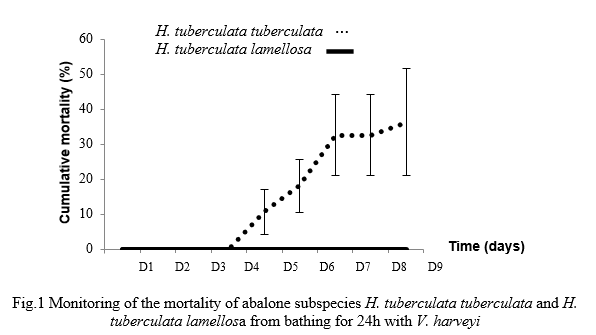IS THE MEDITERRANEAN ABALONE HALIOTIS TUBERCULATA LAMELLOSA SENSITIVE TO VIBRIO HARVEYI INFECTION?
Introduction
Vibrio bacteria are the principal agent of serious diseases in shellfish aquaculture worldwide (Shruti, 2012). An important example is the bacteria Vibrio harveyi, the main pathogen of the European abalone Haliotis tuberculata. In Europe, among the three subspecies of European abalone, Haliotis tuberculata tuberculata seems to be the only one affected by V. harveyi. A direct link has been shown between the temperature of the sea water and the emergence of this vibriosis (Travers et al., 2009). In all cases described in 1998 on the French coast, mortalities occurred when the temperature of sea water exceeded the threshold of 17°C (Nicolas et al., 2002). While on the Canary Islands, the Azores and the Mediterranean coasts values of seawater temperature are above 18°C during long periods of the year, no episode of abnormal mortality has been reported in two subspecies living there, Haliotis tuberculata coccinea and Haliotis tuberculata lamellosa.
Materials and methods
H. tuberculata lamellosa, was harvested by diving in Murcia (Mediterranean Sea, Spain). H. tuberculata tuberculata was collected from the fish farming Haliotis France. After the acclimatization phase, eighteen groups of 10 abalones each were kept in 3L containers during two weeks in the experimental conditions of the future infection phase. The infection with V. harveyi strain ORM4 was then conducted for two weeks in two temperatures: 18ºC for H. tuberculata tuberculata, and 18 and 24ºC for H. tuberculata lamellosa.
Results
No mortality has been recorded in H. tuberculata lamellosa whatever the temperature tested (18 and 24ºC) (Fig.1).
The first symptom observed in abalone tests was a loss of pedal muscle tone, which one was quickly followed by the appearance of white pustules. These symptoms appeared in all moribund or dead animals. Analysis of the hemolymph of all moribund or dead animals pointed out to V. harveyi as the responsible agent of mortality.
Discussion
This preliminary study is the first to test the sensitivity of the subspecies of European abalone H. tuberculata lamellosa (Mediterranean) against the pathogenic bacterium V. harveyi. Several bathing infections carried out with ORM4 strain have shown absence of mortality in experimental conditions (18 and 24ºC) for this subspecies.
Vibriosis, the main disease affecting H. tuberculata tuberculata in France, appears when seawater temperature exceeds the threshold of 17ºC (Nicolas et al., 2002; Travers et al., 2009). This factor is the main cause of mortalities: when temperatures are up to 17°C, this is not possible to observe development of the disease in bathing infection in laboratory, whereas 18°C temperatures lead to mortalities up to 80% (Travers et al., 2008). In natural environment, the same temperature threshold has been found. In addition, no cases of abnormal mortality caused by V. harveyi were recorded for these two subspecies (H. tuberculata lamellosa and H. tuberculata coccinea). Even if there are more favorable conditions for the development of V. harveyi (24ºC temperature), no mortality was observed during our experiment for H. tuberculata lamellosa.
These results allow to issue an initial hypothesis: H. tuberculata lamellosa is a hardy species in V. harveyi. This must be confirmed by infection by injecting the bacterium according to the protocol of Travers et al. (2008).
References
Nicolas J.-L., Basuyaux O., Mazurie J., Thebault A., 2002. Vibrio carchariae, a pathogen of the abalone Haliotis tuberculata. Diseases of Aquatic Organism 50: 35-43.
Shruti C., 2012. Vibrio related diseases in aquaculture and development of rapid and accurate identification methods. Journal of Marine Science: Research & Development.
Travers M.-A., Le Goïc N., Huchette S., Koken M., Paillard C., 2008. Summer immune depression associated with increased susceptibility of the European abalone, Haliotis tuberculata to Vibrio harveyi infection. Fish Shellfish Immunology 25: 800-808.
Travers M.-A., Barbou A., Le Goïc N., Huchette S., Paillard C., Koken M., 2008. Construction of a stable GFP-tagged Vibrio harveyi strain for bacterial dynamics analysis of abalone infection. FEMS Microbiology Letters 289: 34-40.
Travers M.-A., Basuyaux O., Le Goïc N., Huchette S., Nicolas J.-L., Koken M., Paillard C., 2009. Influence of temperature and spawning effort on Haliotis tuberculata mortalities caused by Vibrio harveyi: an example of emerging vibriosis linked to global warming. Global Change Biology 15: 1365-1376.
Travers M.-A., Basuyaux O., Le Goïc N., Huchette S., Nicolas J.-L., Koken M., Paillard C., 2009. Influence of temperature and spawning effort on Haliotis tuberculata mortalities caused by Vibrio harveyi: an example of emerging vibriosis linked to global warming. Global Change Biology 15: 1365-1376.
